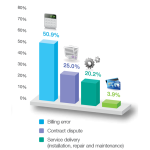The planning and implementation of a Unified Communications (UC) system provides IT the opportunity to think and act strategically, to gain recognition as business leaders, and to add value to their company in a new way.
From my experience, the majority of IT departments are comfortable with being tactical. When the end-of-life phone system replacement arises, IT departments often view this as a like-for-like replacement – a Life Cycle Management task that is required to maintain the current state. The rest of the organization views this as additional overhead and employees typically do not notice any changes within their work environment.
More often than not, a like-for-like phone replacement
- Does not meet the needs of each department
- Does not support the vision of the company
- Does not provide a competitive advantage over the competition
- Does not meet/exceed growing customer expectations
- Does not improve service quality
Whereas, a UC system can be tailored to support and improve business processes (read part 1B for an overview of the benefits of UC).
In addition, UC provides IT departments with a unique opportunity to think and act more strategically, to gain recognition as business leaders, and to fundamentally change the way their company does business.
Some IT departments are capitalizing on this opportunity, and are obtaining praise within their organization for doing so. For example, prior to our engagement with a recent municipality client, a like-for-like phone replacement was agreed upon and scheduled for. However, the implementation was cancelled when a new IT manager determined that this replacement did not support the needs of the municipality. The IT manager was commended by C-level executives for cancelling the phone replacement and for identifying the need to plan and implement a UC solution.
It is important to keep in mind, that the planning and implementation of a UC solution is a difficult task. It may very well be the toughest project for IT departments to date. In fact, 80% of UC projects never meet full potential. A big part of this is due to the complexity of UC; with complexity comes risk. The best way to reduce risk is to plan effectively, and have the right resources on hand.
Bottom line, a UC project is a major business decision that requires careful consideration of the technology, and how it will impact people and business processes. Whether IT tackles this project alone, or hires additional expert knowledge – this project will empower IT departments to lead positive change within their organization.
I hope my blog series allowed you to see the exciting opportunity that UC presents for your business. Furthermore,I hope that you have gathered useful information to help you with your UC project. If you have any questions about my UC series or about Nielsen IT Consulting Inc.’s services – connect with me on LinkedIn, or contact Nielsen IT Consulting Inc. here: https://www.nielsenitconsulting.com/contact-us/
Emily Nielsen,
UC Specialist & President of Nielsen IT Consulting Inc.
UC Strategic Planning Blog Series – Table of Contents
Having a plan is the first step to leadership. Follow our eight part blog series to learn key actionable items that are crucial to developing an effective UC Strategy for your company.
- Part 1a: UC Considerations
- Part 1b: UC Considerations Continued
- Part 2: The Importance of a Unified Communications Strategic Plan
- Part 3: The Discovery Process
- Part 4: Defining Your Vision
- Part 5: Identifying Corporate Requirements
- Part 6: Identifying UC Applications
- Part 7: Infrastructure Assessment
- Part 8: Final Thoughts




